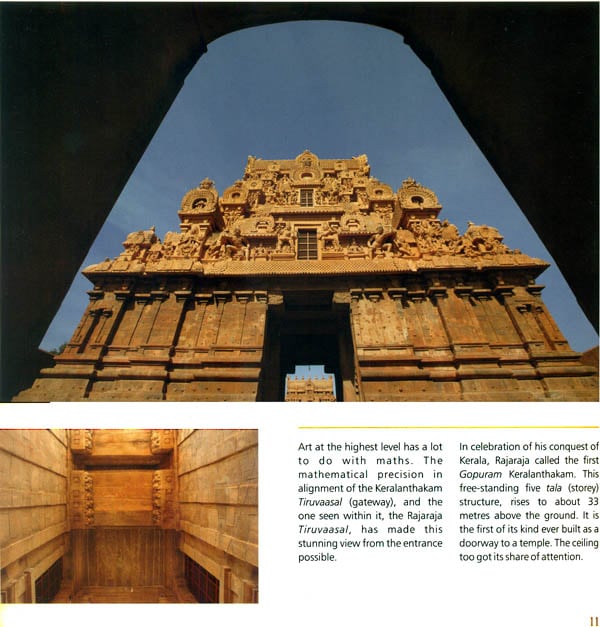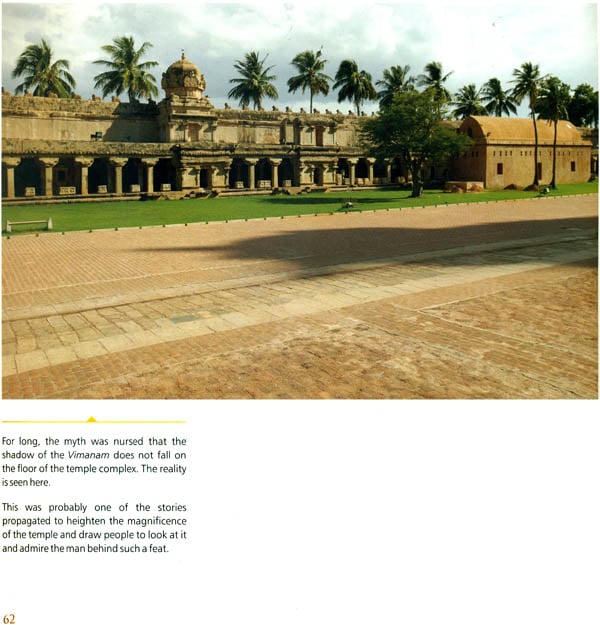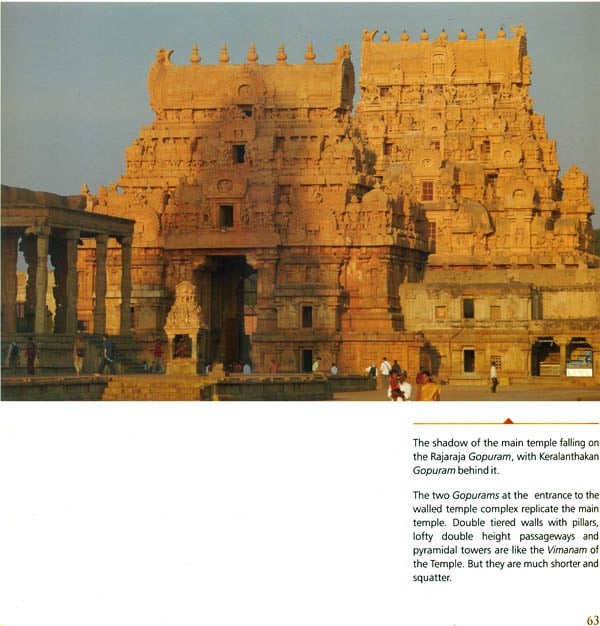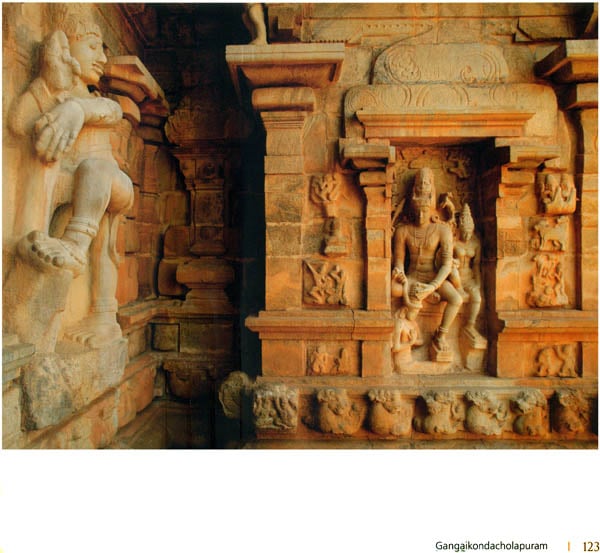
Vibrant at 1000 Big Temple, Thanjavur, India
Book Specification
| Item Code: | NAM722 |
| Author: | Iqbal K Mohamed and Anuradha Iqbal |
| Publisher: | Enrich EduCDs, Chennai |
| Language: | English |
| Edition: | 2010 |
| ISBN: | 9788185984438 |
| Pages: | 141 (Throughout Color Illustrations) |
| Cover: | Paperback |
| Other Details | 9.0 inch x 9.0 inch |
| Weight | 720 gm |
Book Description
Vibrant At 1000: Big Temple, Thanjavur, India, which honour-, till' millennium of the consecration of Rajarajeswaram and is elegantly produced, IS a tour de force. It is a well conceived and beautifully crafted secular exploration ("visual walk- through") of a creation that (in Anuradha's words) "has no equal in sheer scale is exquisite but does not tax the senses is mathematically precise, yet creatively dynamic tranquil and inspiring." Iqbal's photography hero is joyous, admiring, rich in art and historical whispers and intirnations. offering stunning images like the opening with the birds set off against the blue sky and the vimana. or the Image of people crowding around the priest with the Aarti, a work of magic realism.
But It is a photography that works within an aesthetic of restraint, which avoids the artiness of self-conscious art and leaves you with the feeling not of surfeit but of wanting more through this particular lens.
The Brahadiswara Temple in Thanjavur in Tamil Nadu is one of the wonders of the world. In inscribing it, along with two other Chola temples, as a world heritage site in 1987, UNESCO extolled it as "an outstanding creative achievement" in the architecture of a new form of temple, a exceptional testimony to "the development of the architecture of the Chola Empire and the Tamil civilization in Southern India," and an outstanding example of "the representation of the Chola ideology" . All this it is and more.
Known as Rajarajeswaram during the Chola period, the Big Temple, as it is popularly known today, combines history and the present with haunting magnificence. It was the great project of Rajaraja I (985-1014 CE), one of the most illustrious rulers in the history of India, and was completed in 1010. The unprecedented scale; the purity and simplicity of design setting off the complexity of execution; the inspired structural innovations, including the design of the 60-metre-tall Vimana (the tower over the sanctum); the detailed attention paid to the well-being of worshippers; the wealth of historical, and especially secular, information contained in the inscriptions onsite; the ingenious use of the Temple as a centre for the education of the people on the norms of good governance and for propagating the ideology of the Chola Empire; the yet-to-be-conclusively-resolved puzzle of the science behind the engineering and building of this stupendous temple; and the sculpture testifying to the high-grade skills of the artists and artisans who executed Rajaraja's awe-inspiring project - these continue to capture the imagination of millions of visitors in ways few other religious monuments in the world do.
Iqbal Mohamed is an award-winning professional photographer and a pioneer in professional photography education in India. Photographing the Big Temple in all its facets, in all its glory, from every conceivable angle, must be on the agenda of many photographers. But it is also clear that Iqbal's interest in history, which he read for his first degree at my alma mater, Loyola College in Madras, has drawn him like a magnet to the subject of this book.
Vibrant At 7000: Big Temple, Thanjavur; India, which honors the millennium of the consecration of Rajarajeswaram and is elegantly produced, is a tour de force. It is a well conceived and beautifully crafted secular exploration ("visual walk-through") of a creation that (in Anuradha's words) "has no equal. .. in sheer scale ... is exquisite but does not tax the senses ... is mathematically precise, yet creatively dynamic. .. tranquil and inspiring." Iqbal's photography here is joyous, admiring, rich in art and historical whispers and intimations, offering stunning images like the opening with the birds set off against the blue sky and the Vimana, or the image of people crowding around the priest with the Aarti, a work of magic realism.
But it is a photography that works within an aesthetic of restraint, which avoids the artiness of self-conscious art and leaves you with the feeling not of surfeit but of wanting more through this particular lens.
Technical mastery but also emotion are evident in the evocation of the no-Ionger- timeless beauty of the Chola frescoes that were rediscovered, on April 9, 1931, by a humble university lecturer, S. K. Govindaswami, after being plastered over for centuries to exhibit lesser art of a later dynasty. This art form is not only extremely rare in early South Indian history; K. A. Nilakanta Sastri, the outstanding historian of Early South India, viewed the frescoes with Govindaswami soon after the sensational discovery and concluded that they belonged to the 11th century, which raises the possibility of Rajaraja I himself commissioning and admiring them in the vestibule. Does the camera evoke a sense of sadness over historical loss or do I imagine?
I invite you to accompany Iqbal on this visual walk-through, share in the wonder that was and is Rajarajeswaram, experience the emotions evoked by Shelley's immeasurably sad poem, Ozymandias (' ... King of Kings/Look at my works, ye Mighty, and despair ! '), marvel at the Big Temple's preservation over the centuries, imagine that one historical era could be collapsed into another, and come out awed and inspired.
This book is the story of a 1000 year old living Temple, that is more than a place of worship, and of a great emperor, who built it with unique vision that transformed the life of a 'people'
"Makkalai Aandar Nattai AIla" - an emperor who did not just rule over territories but one who ruled over the hearts of his people. The name of Rajaraja Chola I, has thus been etched in history, and with good reason.
By the 19th year of his reign, Rajaraja I had a vision to build a temple, not only as a centre of religion, but as the centre of life for his people.
He added facets to it rooted in the belief that in order for fine arts like sculpture, music, dance and drama to flourish and become a part of life, it must be combined with religion.
The Big Temple, Thanjavur also called Brihadeeswara or Rajarajeswaram, was consecrated on the 275th day of the 25th year of Rajaraja's reign (22nd April 1 01 0).
This Temple has been the subject of long and serious study.
Eminent archaeologists, historians, sociologists and art experts, from India and abroad, have examined and analyzed every aspect of this artistic and archaeological wonder.
The Temple set standards in architecture, design, structural engineering and sculpture. It also defined the life of the people in ways never seen before.
In sheer scale, the Big Temple has no equal to date. It is exquisite but does not tax the senses.
It is mathematically precise yet creatively dynamic. Every facet has come together in a brilliant symphony that is timelessly tranquil and inspiring.
This book will take you on a visual walk- through of the Temple. How it re-invents itself over different times of the day and night, under varied lighting conditions, across seasons, guided by the angle of view of the photographer and the way visitors to the Temple connect with it, a cornucopia of visual delights. In effect, the art of photography celebrating the artists who created the Temple.
The text looks beyond the images and attempts to recreate the thoughts and processes behind the nuances of this great edifice.
Also included are a few images of the two Temples, Gangaikondacholapuram and Darasuram. Together with the Big Temple at Thanjavur, they form the UNESCO World Heritage sites - 'The Great Living Chola Temples'.
We hope this book will motivate you to visit these tem pies.













